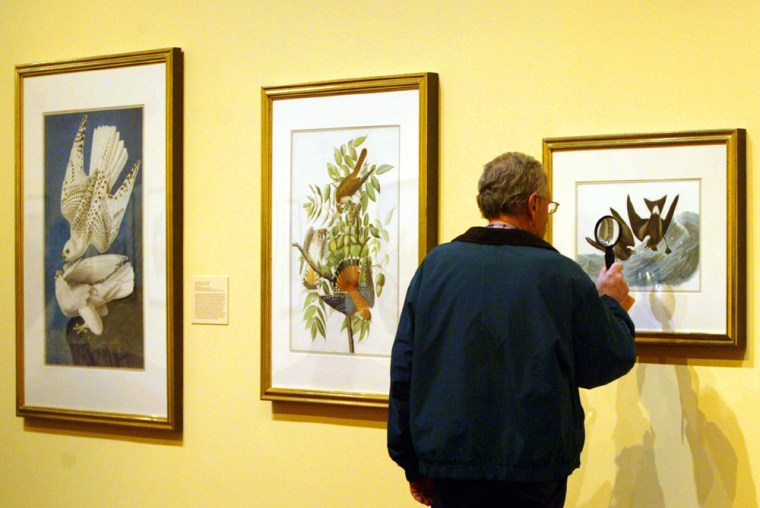A selection of 40 original bird watercolors by American artist and naturalist John Audubon will be on display at the New York Historical Society's annual "Audubon Aviary" exhibit beginning this week.
The fragile watercolors featuring life-size Snowy Owls, Loons, Egrets, Osprey and other birds are part of the society's 435 one-of-a-kind Audubon treasures purchased in 1863 from Lucy Bakewell Audubon, collaborator and widow of the buckskin-wearing naturalist.
The paintings, on display in a spacious elegant room on the second floor of the Society's building, seem to invite the viewer into Audubon's passion for birds.
An observer feels the motion of the birds in nearly all the works: In one, the Osprey, the powerful bird is seen rising with a large fish squeezing the prey with its talons as he proceeds toward the nest to feed its young; in another, the piercing golden eyes of the fluffy white snowy owl engage you viewer wherever you stand in the room.
One can imagine the sounds of the birds chirping and chatting within the pictures. Bird calls screech and caw from speakers beneath some of the paintings to correspond with the actual bird. Audubon, who was an accomplished musician with keen sensitivities, was able to describe bird calls and sounds along with his drawings.
There is a video showing several of the birds in their habitats, including the flamingo, the golden eagle and the egret. The egret, the symbol of the Audubon Society, is seen gracefully walking with its stiltlike legs and in flight with its huge wing span. Next to the video is Audubon's painting of the egret. Audubon was precise in trying to duplicate the movement of the egret in his drawing.
"Everything he drew encapsulates a bird's characteristics," Roberta Olson, curator of the Audubon Aviary, said.
Audubon, a self-trained artist, was considered an innovator. He used watercolors with pastels, black ink and oil and graphite together in the same illustration. His birds were life-size and he drew them in all positions not just profiles, both firsts for an artist.
He preferred to draw from life, often hunting the birds and then hanging the species from a string to paint them.
Each of the 435 original watercolors owned by the Historical Society served as the preparatory models for the production of copper plates ingeniously engraved by Robert Havell, Jr. in his studio in England, which were used for Audubon's most ambitious work, "The Birds of America." One of the copper plates, the house wren, is part of the exhibit.
The son of a sea captain, Audubon was born in Haiti and spent most of his childhood in France where his father encouraged him to observe birds. He was brought to Pennsylvania by his father when he was 18 to manage his father's estate, Mill Grove, near Philadelphia and to avoid being drafted into the French army.
The watercolors were bought by the Historical Society for $4,000 but are considered "priceless" today, according to Olson.
There is such a demand from the public, artists, historians, naturalists to view the paintings but because they are so fragile and light sensitive, the Society will only be displaying 40 of them once a year. This year's exhibit runs from Feb. 18 through March 27.
